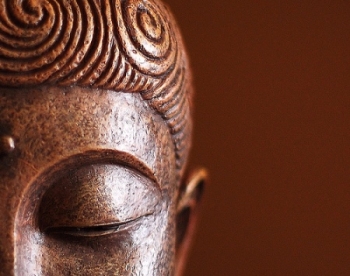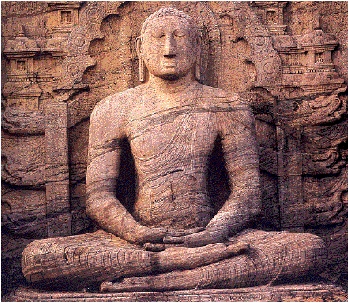When as an undergraduate philosophy student, I was to write on the concept of self-identity, naturally my thoughts traversed the extensive literature covering the topic and intensified my reflections on it. Those mind meanderings led me to a belief resembling the concept of emptiness, which I would then share with other students who were equally eager to express their own views. Arguments naturally are endowed with the ability to convince - swift sword of reason is powerful, but only against an armor that is of the same kind. That is to say a powerful argument at most achieves agreement in virtue of its valid structure, and as such stops there - at the reason's wall, rarely piercing deeper. There’s a method which compliments reason, by transcending it – I’m talking of a mind image, a hypothetical scenario which is not presented as an argument, but rather as an object of direct and immediate experience. When presented to the listener it pierces through the wall of reason constructed out of preconceptions, and triggers intuition and is surprisingly illuminating. Hence I’ve found it as a skillful tool when sharing insight.
The example I’d like to give here has been primarily used as a means to augment the delivery of the view that the inherent self is but an illusion. I subsequently have learned that this approach is similar to some Buddhist methods employed in the same context - the gradual process, guiding toward the realization that there’s no inherent self as I’ve found in His Holines' Dalai Lama’s teachings, as he expresses Nagarjuna's doctrine of emptiness, was carried out in the following way; first you need to make your misconception concrete, by identifying the phenomenon of self as supposedly possessing some inherent existence; in the next step you examine the only possible modes of its inherent existence by narrowing its nature to either being identical to the mind-body complex or separate from it. The final step shows absurd conclusions of the one mode or the other, which by reductio ad absurdum leads one to conclude that such inherent self is impossible. This was just a gross summary of what is a very comprehensive and systematic teaching method – mainly due to the clarity of analysis and the unique Buddhist emphasis on meditating at each step to ensure that the realization is not only intellectual – it is to have the character of a direct and immediate realization. The proof by contradiction is only a guide.
The method I’ve been employing is of a significantly lower caliber, but could be considered as a little step toward the same goal. It has the form of a thought experiment which intends to prune away the significance of certain attributes which some of us deem as intrinsic to their self. This tendency of erroneous attribution is an indication of the erroneous view that there's an inherent, intrinsic and substantial self and hence it has intrinsic attributes. I need to stress that my intention is not to deprive the conventional and practical idea of self of those attributes, but the illusory one that somehow some of us strongly identify with and endow with an inherent existence. After all the former are useful, pragmatic labels which help us to navigate through the world (just like the name-only label “I” is useful to refer to the phenomenon which is typing these words, when uttered by it). However the danger of attributing those qualities to some inherent self is that it always leads to either false pride or some form of dissatisfaction or suffering. Hence the goal of this thought experiment (I’ll present it shortly and your patience is of great caliber if you persisted reading thus far without skipping to the end:) can be described as a little device intended to achieve the result Nagarjuna speaks of in Precious Garland of Advice:
The example I’d like to give here has been primarily used as a means to augment the delivery of the view that the inherent self is but an illusion. I subsequently have learned that this approach is similar to some Buddhist methods employed in the same context - the gradual process, guiding toward the realization that there’s no inherent self as I’ve found in His Holines' Dalai Lama’s teachings, as he expresses Nagarjuna's doctrine of emptiness, was carried out in the following way; first you need to make your misconception concrete, by identifying the phenomenon of self as supposedly possessing some inherent existence; in the next step you examine the only possible modes of its inherent existence by narrowing its nature to either being identical to the mind-body complex or separate from it. The final step shows absurd conclusions of the one mode or the other, which by reductio ad absurdum leads one to conclude that such inherent self is impossible. This was just a gross summary of what is a very comprehensive and systematic teaching method – mainly due to the clarity of analysis and the unique Buddhist emphasis on meditating at each step to ensure that the realization is not only intellectual – it is to have the character of a direct and immediate realization. The proof by contradiction is only a guide.
The method I’ve been employing is of a significantly lower caliber, but could be considered as a little step toward the same goal. It has the form of a thought experiment which intends to prune away the significance of certain attributes which some of us deem as intrinsic to their self. This tendency of erroneous attribution is an indication of the erroneous view that there's an inherent, intrinsic and substantial self and hence it has intrinsic attributes. I need to stress that my intention is not to deprive the conventional and practical idea of self of those attributes, but the illusory one that somehow some of us strongly identify with and endow with an inherent existence. After all the former are useful, pragmatic labels which help us to navigate through the world (just like the name-only label “I” is useful to refer to the phenomenon which is typing these words, when uttered by it). However the danger of attributing those qualities to some inherent self is that it always leads to either false pride or some form of dissatisfaction or suffering. Hence the goal of this thought experiment (I’ll present it shortly and your patience is of great caliber if you persisted reading thus far without skipping to the end:) can be described as a little device intended to achieve the result Nagarjuna speaks of in Precious Garland of Advice:
The reality is later ascertained,
Of what was formerly imagined by ignorance.
Of what was formerly imagined by ignorance.
Now that the theme has been sufficiently built up, we can proceed and give you the opportunity to partake in its hopefully liberating effect. It is quite simple really - I’d like you to bring to mind five unique adjectives which you believe describe you, and you dearly identify with. Take your time, there’s no rush – it has to be done thoroughly in order for the effect to be fully appreciated. Ready? Now realize how many, if any, of those five adjectives would remain valid if you were the only human being? How about if you were the only sentient being?
* * *
I do hope that the above exercise wasn’t an anticlimactic disappointment considering how it has been built it up. I’m aware that many readers of Buddhistdoor may be already cleansed of some gross misconceptions the exercise was meant to eliminate, and thus would not feel it as having a powerful effect, if any. Nevertheless, this trend of thought had a profound effect on me that I could only call liberating. This is why I chose to share it with you.
Read Mariusz's essays here!
















